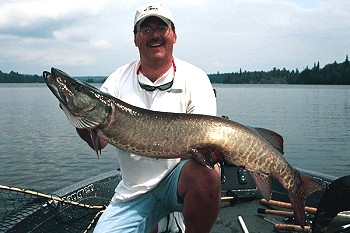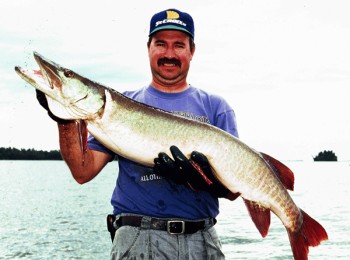
Fifty-two inches is a lot of musky, and by the time the last bit of its tail paddled off into the gloom, my boat had drifted to the structure from which the fish had roared out. Kevin Schmidt and I paused in the middle of our celebratory high-fives to peer over the side and gawk at the arrangement of boulders.
‘It’s a garage,’ Kevin blurted out. ‘Doesn’t it look like a garage foundation?’
I couldn’t disagree. Oval and rectangular-shaped rocks seemingly took the place of cement blocks and were arranged in sort of a C-shape, with the open end facing toward deeper water, with one large boulder in the far left corner. It was alongside the boulder that Kevin had dropped a 9-inch Grandma bait and long minutes later the big musky that had been residing there was posing for a photo.
Since that day Kevin and I have gone out of our way to fish what we call garages but are nothing more than small, cup-shaped bays and rock formations that ‘ considering the number of large muskies we’ve caught from them ‘ are either heavily used by the fish or merely overlooked by most anglers.
Well, maybe all but one. Last summer, while talking with premier Lake of the Woods guide Bill Sandy about a 50-incher I’d caught, I explained how the fish was located in a tiny cut in the rocks along an island shore.
‘Is that the one with some reeds in the back, a little cabbage and a downed tree in it?’ Bill asked.
‘That’s the one. The 50 was tucked in between the tree and the cabbage,’ I replied.
‘That’s a good spot,’ Bill smiled.
A Garage by Any Definition …
Last season, with low water common throughout the northern states and Canada, I had a great opportunity to visually inspect some of the spots from which I’d caught big muskies over the last couple of years. And the findings were … garage, garage, garage.
While fishing along one island complex on Lake of the Woods last year, I discovered that a spot that held a giant fish that I’d missed the year before was now high and dry. Looking at the rock formations on either side of the exact spot where the fish had been holding, Kevin turned to me and asked, ‘Does it surprise you there was a big fish there?’ When we rounded the island’s corner and neared the site where I’d once taken a 49-incher, and another friend had caught a 54-incher, I said: ‘Would you look at this? It’s another garage.’
Garages typically are no more than 20 feet wide and some measure no more than four or five feet wide. Some anglers might describe them as the slots between rock fingers, but this pattern also seems to apply to tiny C-shaped bays cut into rock walls. The very best include some kind of additional structure such as rocks in the middle of them or a rock finger extending from one corner. Some form of cover in the garage adds another dimension ‘ rushes or cabbage are always good, and the branches of a downed tree can be tremendous.
Breaking garages down further, it seems that fish tend to hold in the slots between the garage walls and cover, or between cover types. As with any musky spot, a steady wind blowing into the garage’s opening will considerably increase the chances of an active big fish being present.
But really, it should come as no surprise that muskies use these areas. Weed fishermen have long known that inside turns or slots in weedbeds make them better than just a straight weed edge, with often the most active or largest muskies tucked way back inside the turn or slot. If you can visualize the shapes of your favorite weed edges, and then apply these same shapes to rock formations or rock walls, you’ll readily understand what I’m describing.
 Why big muskies use these seemingly unimportant hideouts is anybody’s guess. Perhaps they afford efficient ambush locations, or maybe the shape of the spot itself helps a feeding musky corral baitfish ‘ during a Wisconsin study, researchers found that muskies feeding in featureless hatchery ponds used the edge of the pond’s plastic liner to herd baitfish. Maybe the fish feel more comfortable tucked back into structure or cover, or perhaps they’re just not harassed by anglers much because the spots are overlooked. Quite possibly all of these factors have some effect.
Why big muskies use these seemingly unimportant hideouts is anybody’s guess. Perhaps they afford efficient ambush locations, or maybe the shape of the spot itself helps a feeding musky corral baitfish ‘ during a Wisconsin study, researchers found that muskies feeding in featureless hatchery ponds used the edge of the pond’s plastic liner to herd baitfish. Maybe the fish feel more comfortable tucked back into structure or cover, or perhaps they’re just not harassed by anglers much because the spots are overlooked. Quite possibly all of these factors have some effect.
The best time of year for fishing garages seems to be early to midsummer, when fish are actively using shallow areas. However, while the shallow parts of a garage may not hold fish in the fall, any available rock fingers reaching toward deeper water will now be the target area.
Finding your own garages is not something that can be done in advance because they’re too small to show on most maps ‘ you’ll have to actually go fishing to locate them. Nooks and crannies that seemingly beg for a cast are what you’re looking for, and this article has been written to tell you to give these spots more than a passing glance or a single cast.
I’ll bet you can think of a few spots on your favorite structures already.
Cleaning Out the Garage
Garages usually require pinpoint casting and are tailor made for the guy who prides himself on placing his lure exactly where he wants it. A superficial approach with a couple of casts to the garage opening may produce a fish that is willing to chase, but it pays to position your boat within easy casting distance of the garage’s farthest reaches and pick it apart with accurate casts.
It doesn’t matter what you cast so long as the bait is appropriate for the depth and cover the garage contains. Certainly in low light conditions a topwater would be my first choice, and if the weather is warm during the summer a bucktail also is prime.
Because garages are so small, it’s imperative that you synchronize your bucktail so that it’s moving back toward you when it hits the water rather than sinking to produce an immediate reaction by a resident fish. To synchronize, thumb your reel’s spool as the bait is about to hit the water, engage the reel when it does, and start reeling quickly. This not only helps the bucktail lay out better to minimize fouling, but it starts the blade spinning immediately and usually catches air behind the blade, which produces a bubble trail. All of these factors may trigger a hot fish in a tiny spot.
A jerkbait or twitched minnowbait may be a better selection in either bright or post-frontal conditions, or during cool water periods. A crankbait walked down the rocks on either side of the garage may be the ticket at any time. In these cases, collisions between the bait and structure or cover may be the triggering factor. If your jerkbait, minnowbait or crankbait bumps into weeds or hangs up in them, remember to ‘explode’ the bait into open water by ripping it hard on your next pull ‘ this may produce the most explosive strike of the year.
Will garages hold multiple fish? Maybe, but in my experience I can think of only a couple of times when this has occurred. These areas are so small, and in many cases the fish in them have been big, maybe there is a territorial consideration in place here that prevents two fish from using them simultaneously. Or, perhaps, catching the first musky stirs up the spot so much that a second fish in the area may be spooked.
When you recognize a potential garage this season spend the time to thoroughly cover it with casts. You may find that ‘cleaning out the garage’ may become one of your favorite things to do.
